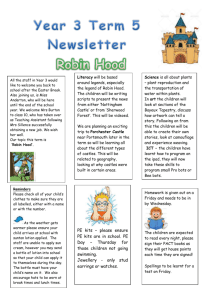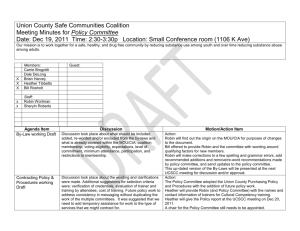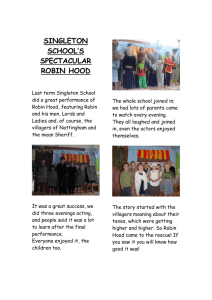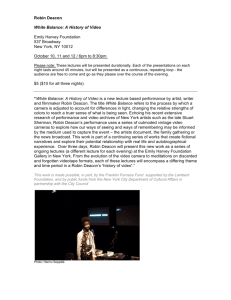Summer Newsletter
advertisement
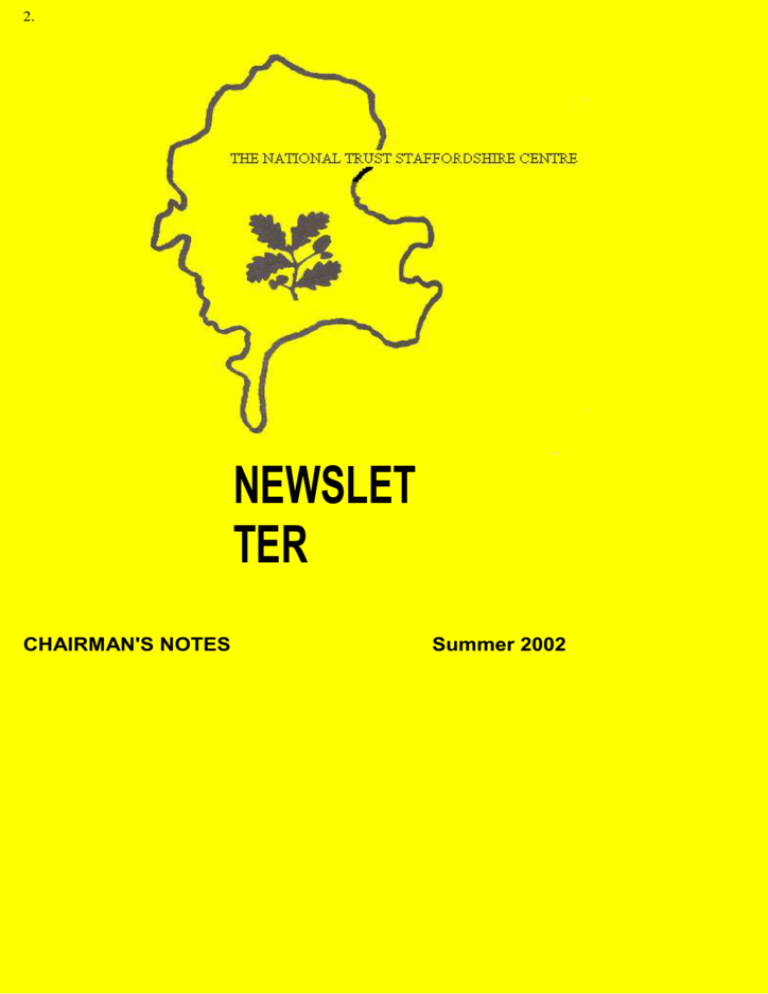
2. NEWSLET TER CHAIRMAN'S NOTES Summer 2002 I wrote my first Chairman's Notes to you for the Summer 1991 Newsletter. At that time I thought perhaps I would be in the post for about five years, but in fact the last 11 years have simply flown past and I am still here! ! No doubt our remarkable communication system has spread the word that I intend to retire as Chairman and as a committee member at the Annual General Meeting in April 2003. I did not find it easy to take this decision but I know that it is right. I have thoroughly enjoyed carrying out the tasks which are involved, though there have been difficult times as well. Now the Centre must look to the future. Many changes are taking place in the National Trust itself, some of them too hastily in my opinion and perhaps without adequate thought for the immediate consequences. No doubt stability and good order will eventually return, but it has made me realise that if our Centre is to prosper there will have to be changes too. These can only be effective and successful if they evolve after careful thought and in an unhurried manner. That is why I have stated my own resolve now, so that the Committee and you, the members, can act without undue haste. This Centre has been unique, because in all its 29 years of existence it has only had 3 chairmen, including me! ! This was not deliberate, it was just the way it developed. I cannot say whether this has been a good thing, though it has certainly produced stability and a steady sense of direction. Some might say that in the face of the changes occurring in our communities and in the Trust itself, such a system could have produced rigidity when the need was more flexibility. I really cannot comment further at this time. What I can say is that you and your Committee now have to look forward and make decisions that will affect the course this Centre will take in the years ahead. I am sure you will do this wisely and after careful thought. My task now is to do my best for you during the remaining months I am in office. Best wishes to you all. Gordon Burgess NEW MEMBERS We are pleased to welcome the following new members who have joined the Centre since the Spring 2002 issue of the Newsletter:Dr M Brown Mrs P Daggett Mr & Mrs J Edmunds Mrs E Grainger Mrs P Quinn Mrs J M Wheeler Rev Dr M Willshaw Lichfield Stafford Great Wyrley Penkridge Cannock Stone Lichfield AN ENTRY IN NEXT YEAR'S DIARY Do make an entry in your diary for next year's holiday to the Scottish Highlands: 6th to 13th April 2003. We shall be staying at The Highlander Hotel, situated in 'Monarch of the Glen' country. The Hotel has been featured in the television series and we shall also be visiting Balmoral. More details later. VISIT TO SALFORD QUAYS, THE LOWRY AND THE MUSEUM OF SCIENCE AND INDUSTRY We set off from Stafford on May 28th at about 9.30 and arrived at the Lowry centre in Salford at 11 o'clock. As the weather was not good we went straight into the exhibition to see Lowry's paintings and drawings which were moved to this new centre in 2000. The pictures were hung chronologically so the sweep of Lowry's artistic career could be followed. I think everyone recognises the "matchstick" figures of his paintings but I was surprised at the variety of his other work including some very interesting human life figures of his early years. After lunch, as the weather had not improved, I went round the outlet shopping area, but nothing took my fancy so my purse remained closed! We boarded the bus again at 2.15 for the short ride to the Museum of Science and Industry. This consisted of five separate buildings each dealing with a different theme one of which was based in the world's oldest railway station. As there was insufficient time to see everything we all went our separate ways depending on our individual interests. I went first to the Power Hall and as soon as I entered the building it took me back to my childhood days and the steam trains because of the very distinctive "smell of steam". Here there were working steam engines, steam trains, vintage cars, motor bikes GUESS WHO? and bicycles and a water wheel. 3. I next visited the station building where they had recreated an old booking hall. Then I went underground Manchester to see the sewers, and discovered how poor sanitation made Manchester an unhealthy place in which to live in the 1800's. I had a quick visit to the Fibres, Fabrics and Fashion section which showed the sequence of machines used in the cotton industry for which Manchester was famous in years past. They began with the machine for breaking the raw cotton from the bale right through to the weaving machines. Here there was also a film showing how the "lady of the house" should do the washing and ironing before the days of the washing machine. Finally I visited the "Xperiment" area where there were all sorts of puzzles to solve by "doing" the experiment yourself. Here I met a young boy oh about 11 who was very willing to show me all sorts of things - he had obviously been there before! Having a youngster there certainly made it more interesting so I must remember to take my grandchildren when they are old enough! ! We only had a brief taste of what the museum had to offer but I guess many people will want to go again to study some things in more detail. Then it was time to leave so we boarded the bus for the journey home. Thank you Jean for a very interesting trip. Rosemary Beynon MEMORIES RECALLED BY THE NATIONAL TRUST VISIT TO SALFORD QUAYS As Salfordians, my wife and I looked forward to the National Trust visit to the Quays, but we were quite unprepared for the delightful transformation that had been made to Salford Docks and the surrounding areas. We had lived in Stretford for a year or two in the late' 40' s, but until the coach approached the Manchester United Football Ground we had hardly recognised any of the old landmarks. Seeing the Quays was a revelation to me, and many memories from over 60 years ago came flooding back. As part of my early training with the then Post Office Engineering Department I was attached to the Trafford Park Telephone Exchange which was located immediately to the south of the Swing Bridge on Trafford Road. Naturally some of the work involved outside maintenance and one of my early recollections was of fitting a ship to shore telephone link to one of the big Manchester Liners. In 1940 the quays of both Salford and Manchester docks were chock-a-block with ships of all shapes, sizes and nationalities. With the exceptional flow of shipping traffic, the turning of the Swing Bridge occurred very frequently and to those of us who lived in Salford; to be 'bridged' was no excuse for being late for work. Obviously, in those dark days, the docks and the big engineering complex of Trafford Park, which included Metropolitan Vickers, Ford Motor Co., and many large and small firms making aircraft parts, offered a very inviting target for German Bombers. On Christmas Eve, 1940 we suffered severe damage to Trafford Park area and every cable into the telephone exchange had been cut. I spent Christmas Day, that year, wearing a tin hat, tracing and clearing faults in the 'locked up', powerless exchange, whilst on the other side of the wall, four sappers were digging away - quite unconcernedly, and even drinking tea which we supplied - to retrieve an unexploded bomb. The factory on the other side of the road was completely demolished. A few weeks later when on evening duty, a 'land mine' was dropped on Trafford Road, just opposite the Docks entrance, devastating a half square mile, and I am convinced that the whole of the exchange building lifted some three or four inches in the air and dropped back again. The remaining solitary tower of StoweIl Memorial Church that we passed on the corner of Eccles New Rd., and Trafford Rd. was a grim reminder that cycling to work up Trafford Rd. meant carrying my bicycle on my shoulder and picking a way through the rubble. The Vicar's son had been a personal friend of mine and a year before the damage to the church we had spent many happy hours in his garden at the back, modifying a 1932 Ford 8 to run on 'unrationed' paraffin. Before being called up into the RAF, I spent most of my 'civilian' time in central Manchester, but even there, despite the bombing, life seemed quieter away from 'Salford Quays'. Norman Fox [I am sure many other members of our Centre must have many fascinating memories of the kind described in the above article, which would be of the greatest interest to our readers. Why not write about them for the Newsletter? Editor] SCOTTISH CASTLES The coach left Lichfield at 7 a.m. on Monday 29th April, picking up 41 members travelling north on the A1 to Edinburgh and the Forth Bridge, arriving at our Hotel in Perth at 6.30 p.m. Our first day started with a visit to Blair Castle just north of Pitlochry, the home of the Dukes of AthoIl and one of the many houses with connections to Mary Queen of Scots. After lunch we went to Kenmore to see a Crannog, an Iron Age dwelling built on stilts and standing in the loch. BLAIR ATHOLL CASTLE The second day started with a visit to Discovery Point in Dundee to see the Discovery, Captain Scott's famous ship, to learn how she was built in Dundee and equipped for his voyages to Antarctica. The day continued with a visit to Arbroath Abbey where in 1320 Scottish nobles swore to independence from England in the "Declaration of Arbroath" . We then made our way to Glamis Castle the home of the Earl of Strathmore, the Bowes Lyon family and where the late Queen Elizabeth the Queen Mother was brought up and regularly visited during her lifetime. It was a smaller castle than some and a comfortable family home. The third day took us off to Pitlochry and Edradour, the smallest distillery in Scotland. After being welcomed, we were given a "wee dram" and shown a video about Edradour and the production of whisky . We were then taken on a tour being shown where the water is added to the malted barley and heated. Yeast is added later for fermentation, followed by double distillation, before being put in sherry casks; where it is stored for ten years, during which time the whisky gets its colour. From there we were taken to Scone Palace where in the past, the Kings of Scotland were crowned. It is the home of the Earls of Mansfield. SCONE PALACE CHAPEL 4. After lunch we continued to Elcho Castle, now only a shell but with some floors. This was, in the 16th century, a fortified mansion with three unusual projecting towers. Our final stop of the day was Huntingtower Castle, which has superb early painted ceilings in its two towers. We beat a hasty retreat as a thunderstorm crashed around us. On Friday we started our day with a visit to Loch Leven where we were taken by boat to an island in the middle of the Loch to see Loch Leven Castle. The building was in a similar state of repair to Elcho Castle, where in 1568 Mary Queen of Scots abdicated whilst a prisoner in the 14th Century tower. The Loch was very peaceful that day and we also saw an osprey flying overhead. We continued to Edinburgh where we had a chance to see Scotland's No. 1 visitor attraction, Edinburgh Castle. Here guided tours started at the Gatehouse and various points of interest were pointed out, giving the history as they proceeded. At the end of the tour the main features including the Scottish Crown Jewels and the National War Museum were recommended to visit. Saturday we set out for Stirling Castle, probably the grandest of all the Scottish Castles, both from its situation on an extinct LOCALS OUTSIDE EDINBURGH CASTLE volcano and its architecture. Restoration is taking place, the Royal Palace of James V, and the Great Hall were magnificent. We later returned to Perth, omitting Bannockburn, so that we could see the City in which we were staying, whilst the shops were open! The National Trust of Scotland own the lovely Branklyn Gardens across the river from the centre of the City. Some of us made the uphill walk to visit the gardens and enjoyed meandering along the paths between the wonderful flowering shrubs and flowers and sitting admiring the scree gardens before the pleasant walk back to the hotel. We even had time for shopping and a welcome cup of tea. Sunday, our last day dawned bright and sunny as all the others and we left Perth heading first for Falkirk to see the Falkirk Wheel. Unfortunately it had been vandalised and we were not allowed on the site. However, we managed to hire a boat for a trip along the canal to see the "Millennium Wheel". Eleven of us went on this very pleasant journey whilst others walked along the tow path. The "wheel" is capable of raising 8 boats at a time from one canal to the other at a different level. We stopped for lunch at Moffat, then continued south and after a short stop at Scotch Corner arrived back in Stafford at 8pm. We had a wonderful six days away with beautiful weather except for one wet afternoon and JEAN WOOTTON SOUNDING "EIGHT BELLS"! the heavy shower/thunderstorm at the end of a good day out. Scotland was certainly seen at its best. Many thanks to Joe and Jean, and John the Driver, for an excellent holiday. Brian Taylor [Mr & Mrs Brian Rowe, of 8 The Seesall, Gnosall, Stafford ST20 OHH (tel: 01785822579) have written a much fuller account of the Scottish Holiday which is too long for inclusion in the Newsletter, but they would be glad to let anyone who so wishes have a copy. Just telephone and ask for one!] THE LOVES OF DR SAMUEL JOHNSON Mrs Brenda Knight gave us a sketch of the life of Dr Samuel Johnson who was born in Lichfield in 1709. This great English writer and lexicographer is well known for his humanity, especially in his attitude towards poverty and slavery. In this he was undoubtedly in advance of the times he lived in. However, our speaker highlighted another very human aspect of Samuel by talking about the great loves which enriched his life. As a child, he was unhealthy, to the extent that he was taken to London when three years old to be touched by Queen Anne in the belief that she could expel the "King's Evil" as certain problems were called. He carried some of these into adulthood and it seems that he was physically unprepossessing and also suffered from periodic bouts of depression. Nevertheless, there is no doubt that he had a charismatic character and was attractive to the opposite sex, possibly because of his ready wit and sparkling conversation. At one time he was a good friend of the wife of a Birmingham surgeon, Edmond Hector, but he married a widow, Elizabeth Porter, 20 years his senior who was endowed with a valuable dowry. Despite many separations when he was in London and in the company of his friend David Garrick, the actor, who introduced him to a number of ladies of the stage, Johnson seems to have been faithful to Elizabeth throughout her life. After her death he found solace in the company of Mrs Hester Thrale, the wife of a wealthy London Brewer, although he also knew other ladies, including Georgiana, wife if the Fifth Duke of Devonshire, who apparently found him intriguing. When Henry Thrale died in 1781, Johnson became his executor and was frequently with Hester, especially in Brighton; in the summer of 1784 however, she announced that she was to marry Gabriel Piozzi, an Italian musician. Although he eventually reconciled himself to this and sent her his good wishes, Johnson did not long survive and died on 13 December 1784. He was buried in Westminster Abbey, a very great honour indeed. This was a fascinating talk which was well illustrated by slides and gave us a different perspective of a man who has often been misunderstood and misrepresented by other writers. It is gratifying to realise that this larger than life figure was also very human and suffered from the frailties of many ordinary human beings too. Thank you Brenda. Written by the Chairman, who forgot to ask for a "volunteer", possibly because of the fact that there were two failures - we could not get into the locked kitchen to provide drinks, and the public address system didn't work because a vital part was not available! He does point out, however, that you do not need to be asked to prepare a report. It would be lovely if someone just said, "I will do it. ANNUAL LUNCHEON 16th MARCH 2002 For many years our Staffordshire Centre has held a hugely popular Christmas lunch in early December. Traditionally, this was at the Staffordshire Showground, and then, following a disastrous fire and a period of unavailability due to reconstruction, in the hospitality suite of the Uttoxeter racecourse. Then again, after booking difficulties, we returned to the splendidly refurbished Staffordshire Showground. At both these venues, our catering was provided by an excellent outside caterer who looked after us well over the years. Latterly, however, the numbers attending this annual event showed a steady decline from a peak of over 200 to a low of 120. The reasons for this were not readily identifiable. Could it have been a slight inconvenience of the venue? Or could it be that there is a plethora of festive lunches and dinners at this time, which is obviously a period when our weather is not at its best, or even perhaps the 'sameness' of the menu - again somewhat bound by convention. Whatever the reason, our Committee took the decision to try both a new time of the year and a new venue for this important social gathering. So it was that the first Spring lunch was held at The Terrace Restaurant. The event was well supported with over 130 Members and their guests attending. at the table, its remarkable service, and the very imposing function room in which we were most comfortably accommodated. One might also mention that the parking was easy and on tarmac! It has been our custom to invite a guest after-lunch speaker, to complement the pleasure of our meal and mutual company. It must be said that some have, as far as the writer is concerned, been better than others! This year, however, the choice was 'spoton', with Mr Paul Spicer being kind enough to accept our invitation to a free lunch! Paul Spicer, although a very distinguished musician, is probably best known to us as the Director of the Lichfield International Festival, which he has organised for eleven years. Last year was sadly to be his last, for he has now returned to his first love - music - and in particular choral music, for it is as a conductor that his international reputation has grown, particularly with the Finzi singers. Having conducted Bach choirs in many of our major cities, Paul now conducts the Chamber Choir of the Royal College of Music in London where he is also Professor of Choral Conducting. Anyone who was not at the lunch, or who did not know him, may, by just reading my description of his achievements, be surprised when meeting him for the first time for what one experiences is not what you might expect. Paul is an imposingly tall man of humorous demeanour with a gift for words and witty anecdote. Who could forget the 'Flanders and Swan' shows which he presented with his friend Andrew Lumsden, the Cathedral organist? Paul's primary instrument, perhaps matching his physique, just had to be the organ, and we were enthralled by his recollections of playing the greatest examples in the country - some of which have pipes 32 feet long! He spoke of being alone in St. Paul's Cathedral at the dead of night, and passing the tombs of Nelson and other great figures in our Nation's history, on his way out to lock up that magnificent church! He described in vivid detail his love and fascination for the wonderful buildings in which he had played, and in particular his abiding admiration for the glories of the Perpendicular Period and the breath-taking fan vaulting so perfected in King's College Chapel, Cambridge. Whilst describing some of our country's great architectural heritage, an aside pointed out that, surprisingly, the Truro Cathedral spire is some 20 feet higher than Lichfield's. Throughout his talk, which was given with such ease, his anecdotes - sometimes at the expense of the viola players in an orchestra - kept us hugely entertained. Paul's slightly quizzical expression confounded his immense knowledge of the subject. How lucky we were to be both amused and educated by such a distinguished Composer, Recording Artist, Choral Supremo and Natural Humorist. All of us present echoed our Chairman's good wishes to Paul for the next phase in his most distinguished career, and demonstrated most warmly our appreciation. See you all next Spring at 'The Terrace' - the room is already booked for Saturday, 15th March 2003. Richard Miller Yardley THE FIRST YEAR IN THE LIFE OF THE ROBIN David Tideswell's introduction to the subject of the evening explored the origin of the name "Robin Redbreast" and the adoption in 1952 by the British Ornithological Society of "Robin" as the official name of one of our commonest birds. He illustrated the appeal of the name of the bird by showing merchandise examples and also various styles of cards including the very widespread Robin Christmas Cards. Then came the wonderful slides showing all the stages in a Robin's life. With some 6,000,000 pairs in the British Isles and males out-numbering females there are intense efforts by the males to secure a mate. The male aggressively defends his territory and uses showmanship to attract a female, who alone constructs a nest - if the male can offer a safe site! Two or three clutches of eggs, each averaging five, are laid, and during incubation the male finds all the food. After hatching, feeding the hungry mouths is shared to such good effect that the birth rate increases ten-fold in about two weeks. Many of the new-born will eventually succumb to predators - cats, sparrow hawks, owls etc and this is frequently the fate of mature birds. Nature in the raw does not permit robins to die of old age, or for the population to increase beyond sustainable levels. The slides revealed an immense love for the robin and must have involved almost unlimited preparation and patience to show the bird in so many poses. We were taken from eggs to hatchlings to the young birds in moult and then with their mottled brown breast feathers. The red breast gradually develops and extends to include the beak and some of the face. The large black eyes permit, with a little head movement, an all round field of vision to give early warning of predators. But the robin has less fear of man and can readily be tamed and encouraged to feed from the hand. An interesting question and answer session brought a fascinating evening to a conclusion with the audience expressing their appreciation for the presentation of a superb series of slides. Cliff Ricketts ANOTHER DAY IN THE LIFE OF THE ROBIN A comparatively small group of centre members were treated, on 16th April, to a truly extraordinary talk about robins - not just the birds, mind, but all things robinesque! Our Chairman's introductory words prepared us for something pretty unusual, but until now, to my knowledge, none of our speakers has ever actually sang to us, still less encouraged us to join in the refrain! The song in question, sung on this occasion in a deliberately child-like voice, went "The red red robin comes bob bob bobbing along ... ". Mr Tideswell, whom you may have seen on television, started by listing some of the instances where the name 'robin' appears in the English language - and there is a surprisingly large number of these, due no doubt to the generally recognised status of the robin as the 'English Bird'. For example we have 'Round Robin', 'Cock Robin', Robin Hood, Reliant Robin, Robin Tobacco, Robin Starch - did you know that Robin Starch often used to serve as a very excellent substitute for talcum powder? - etc, etc. Mr Tideswell' s exhibits included, among other things, a number of hand-painted Christmas cards depicting robins. Initially to the audience's embarrassment, but subsequently to its amusement, he introduced each one of these with the remark "Aren't I lucky to have this?", followed by "Ooeeee" - quite off-putting at first, but we got used to it! After this somewhat eccentric introduction Mr Tideswell began his talk on robins proper, i.e. the birds of that name. His slides were exclusively of robins, photographed for the most part in his garden near Uttoxeter, and these were quite fascinating. I particularly liked the one showing a robin, with his bright red breast proudly puffed out to twice its normal size to impress Miss Robin! Cliff, in the article above, gives a full appreciation of the talk, so I will say no more except to express my disappointment that Mr Tideswell, during the question time which followed the talk, was unable to tell us why all our starlings and sparrows, once so common, have virtually disappeared from our gardens! Thank you, Eric Haylock, for having found such an entertaining speaker for us. Guy de Visme ST. VALENTINE'S DA Y WALK IN DEEP HAYES COUNTRY PARK Great walk - pity about the mud! Seventeen of us, including four visitors, gathered at the Old Tea Rooms and Crafts Centre, Cheddleton on a sunny morning for this walk, ably led by Peter Jobling. Personally, I did not notice much romance in the air! The venue had been changed due to maintenance on the route to the Deep Hayes car park. The journey to the starting point was not uneventful as there had been an accident near where we should have turned. At least one car(us!) missed the turning, and I have been told one person was late and did not manage to find us at all, which was a shame. We started by walking passed the Flint Mill. Peter explained its use, to grind calcined flint for the pottery industry and that the canal branch had been built to deliver and collect goods from the mill. We started off by walking along the towpath, which is part of the Staffordshire way. This was nice and flat and easy. We then turned west across fields, somewhat hilly and muddy with lots of styles. Unfortunately my husband was one of the last over one style, and came over head first. No damage done, apart from an extra load for the washing machine! We walked passed places with interesting names, for example Ladygreen and Little Shaffalong. When Peter first did the 'recce' for this walk, during December, he noticed and reported that a style needed repair. Coincidentally, it had just been mended the day we walked. Well done Staffordshire Moorlands Ranger Service! We did wonder if Peter had anything to do with wrecking the style during his 'recce'. The walk ended conveniently in time for lunch and most people, together with one non-walker who was recovering from an operation, had a very enjoyable lunch in the teashop before returning returning home. Many thanks to Peter Jobling for having lots of information about the area and leading an interesting walk. Joyce Rowe THE WALK AT LILLESHALL It was a fine Spring day as we assembled in the car park of the National Sports Centre awaiting instructions from Eric our leader. This was a walk postponed from last year because of the foot and mouth epidemic. The fine weather had encouraged 31 of us to set out. Is this a record turn out for a walk? We set off down the main drive turning left down a lane bordered by a lovely display of daffodils. Then across a couple of fields sown with Winter wheat, way marked but pathless. The ground was so dry that the clay soil was cracking. No mud to contend with on this walk just a herd of bulls and later some brambles. The former kept a respectful distance and to cope with the latter Eric had thoughtfully brought his secateurs which I think deserves a special commendation. We wound our way to the top of a hill surmounted by a monument to one of the Dukes of Sutherland, erected in 1833 by his grateful tenants and employees. There were fine views all round of the rolling Shropshire countryside but whilst drinking our coffee it was best to shelter from the cool wind reminding us that it was still early Spring. After descending the hill we meandered along a disused canal commissioned by the Dukes of Sutherland to transport coal and limestone. The canal was on two levels connected by an inclined plane on which the barges were hauled up by horses. I am sure that the remaining evidence of this feature would have passed unnoticed had Eric not pointed it out. Eventually we arrived back at the National Sports Centre where a satisfying choice of soup, jacket potatoes and rolls was on offer. Our thanks are due to Eric for organising this very pleasant outing DEREK CONTEMPLATING HIS DESSERT Derrick Andrews RAMBLE FROM ABBOTS BROMLEY The route from the Coach and Horses took us through houses at the eastern end of the village and across the Newborough Road to join footpaths leading southwards across flat fields. After several styles the group of 21 members and guests were strung out for a while until we paused for a coffee break at a crossroads on the Lichfield Road. A minor lane led past Seedcroft Farm to join a section of the Staffordshire Way not far from Blithfield Reservoir Sailing Club. It was extremely muddy for a short section, sufficient to string us out again as we plodded through with difficulty. Two more fields brought us to the back of Abbots Bromley's 14th century church and a short walk up the village street for lunch at the Coach and Horses. Our thanks to Cliff Ricketts for another excellent walk on a beautiful sunny March day, with high winds blowing white clouds over a blue sky. Alan Jutton Mr E Haylock OBE JP 86 Gaia Lane Lichfield, Staffs WS137LS 14 May 2002 Dear Mr Haylock Centres and Associations' appeal in tribute to Her Majesty Queen Elizabeth the Queen Mother Thank you very much indeed for your contribution to the above, the receipt of which I am pleased to acknowledge. I hope you will in turn thank your committee members and members for their support and generosity in wanting to mark Her Majesty Queen Elizabeth The Queen Mother's long association with the National Trust, who as you know served for nearly 50 years as our President. The project to restore the sunken garden and rock garden at Polesden Lacey will serve as the National Trust Centres and Associations' tribute to HM The Queen Mother and will no doubt remind us all of the time Her Majesty spent at the property on honeymoon with HM King George VI. No doubt like you, I look forward to the day when the work will be accomplished and we can visit the property to see what has been achieved. With grateful thanks once again for your support and with all good wishes Yours sincerely Philippa Spackman Associations' Liaison Co-ordinator The National Trust, Heywood House Westbury Wiltshire [We were privileged to welcome Phillippa Spackman, recently appointed as the Trust's Associations Liaison Officer to our Annual General Meeting. She is the main contact at Headquarters for Centres and Associations such as ours.] 5 Overhill Rd., Stafford, STl7 0QA 10/03/02 Dear Mr De Visme, I note with interest your query re 'graduated dip-sticks' in the current NT Newsletter. I expect by now others will have been in touch to explain, but in case not, let me say that Cliff Ricketts is probably right. Before the great blessing of metrication, depth gauges were the same as an engineers' levelling staff i.e. graduated in tenths of a foot. This was to enable the engineer or surveyor to estimate a reading through an engineer's level to the second place of decimals. I illustrate what an engineer would see on looking through the telescope of a level:- In this example the reading on the collunation line would be 7.47 ft. (approx.). In the old fashioned instruments the image would appear inverted, there being no correcting lens. Nowadays, of course, they use lasers. Hope this is of interest. Yours sincerely, Jack Shelbourn JUST PONDERING Sometimes I just sits And I ponder on things, On why we be here And what trouble brings. I'm an old body now And I can't help but sigh 'Cos there's lots I don't know And I keep asking "Why?" And why be there crime? And why must some bodies Be struck down in their prime? Why be there earthquakes And bolts from the sky? I'm just an old body But I keep asking "Why?" P'raps if life was perfect Do you agree? We'd all of us die Of monotony ! Margaret Curtis (Found in a magazine by Sheila Burgess) TWO MINUTES OF FUN SEND + MORE = MONEY Find what each letter stands for. EPONYMS The following items are commonly known eponymously by the name of their inventor, the trade-name of the first product or legendary association. 1. 2. 3. 4. 5. 6. 7. 8 A bread-based snack A calf-length boot. A long waterproof coat. A tractor-based digging machine. A railway dining car. A book of maps. An internal combustion engine. To completely ignore a person or organisation. 8. Self-adhesive transparent tape. 9. A smooth road-surface 11. A small terrier. 12. An electric carpet-cleaner. 13. No choice whatever. 14. A temporary road span. 15. A ball-nibbed writing instrument 16. A front-buttoned woollen garment. 17. A liqueur. 18. An illuminated street-crossing marker. 19. A concoction of fruit and ice-cream. 20. To remove 'rude' words from a published book. (from our Hon Secretary. Eric Tanner.)

